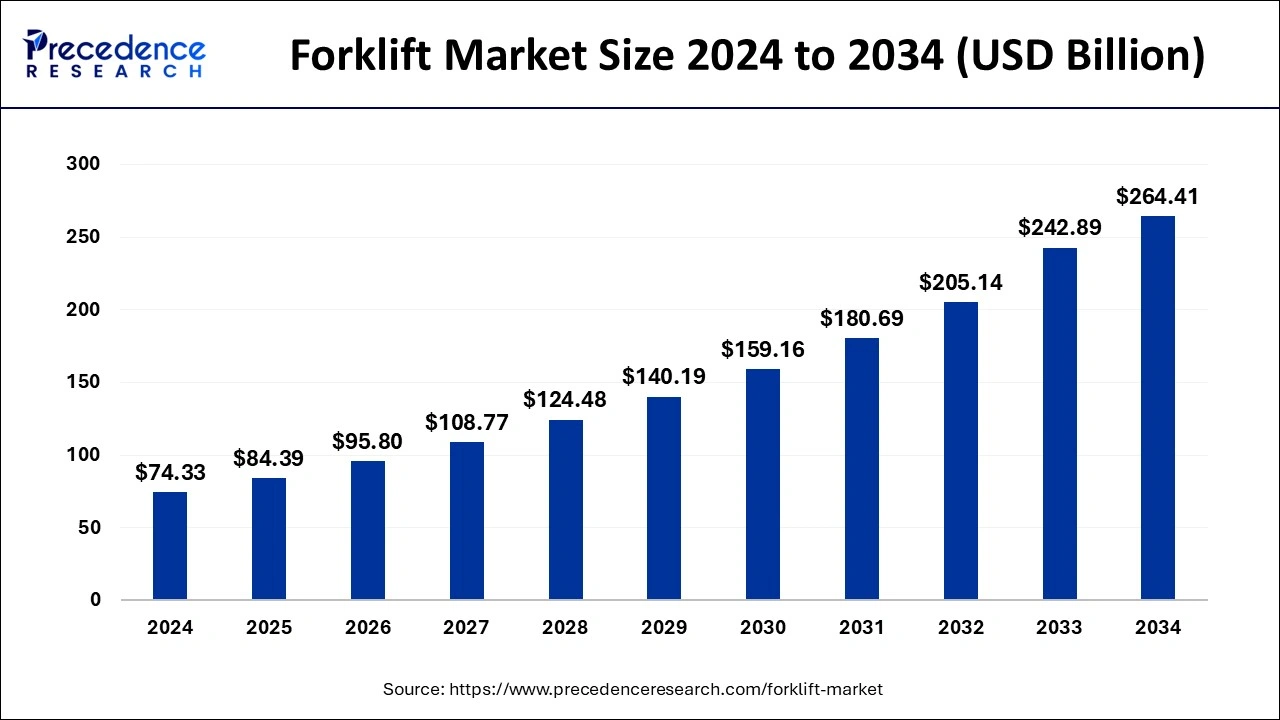The forklift market size is forecasted to rise from USD 74.33 billion in 2024 to USD 264.41 billion by 2034, with a CAGR of 13.53%.
Forklift Market Critical Observations
- Asia-Pacific secured a 48% market share in the global forklift market in 2024.
- Class 3 forklifts led with a 44% share in 2024.
- Electric forklifts emerged as the preferred power source in 2024.
- Forklifts with 5-15 ton load capacity held a significant share in 2024.
- Lead-acid batteries dominated the electric forklift market with a 67% share in 2024.
- Industrial use captured over 25% of the market in 2024.

The forklift market is witnessing rapid growth due to the surge in demand for material handling solutions across various industries. Asia-Pacific holds the largest market share, driven by increased industrial and warehousing activities. The preference for electric forklifts is growing due to their eco-friendly nature and operational efficiency. Market growth is further supported by technological advancements and the trend toward automated material handling systems.
Sample Link: https://www.precedenceresearch.com/sample/1032
Market Scope
| Report Coverage | Details |
| Market Size in 2024 | USD 74.33 Billion |
| Market Size in 2025 | USD 84.39 Billion |
| Market Size by 2034 | USD 264.41 Billion |
| Growth Rate from 2025 to 2034 | CAGR of 13.53% |
| Bae Year | 2024 |
| Forecast Period | 2025 to 2034 |
| Segments Covered | By Class, By Power Source, By Load Capacity, By Electric Battery Type, and By End Use |
| Regions Covered | North America, Europe, Asia-Pacific, Latin America, and Middle East & Africa |
Core Factors
The growth of the forklift market is fueled by the increasing need for material-handling equipment in logistics, manufacturing, and warehouse operations. Industrial expansion, particularly in developing economies, has heightened demand. The rising adoption of electric forklifts driven by environmental awareness and cost-efficiency trends is accelerating the market. Technological innovations and automated material handling solutions also contribute significantly.
Potentials
- Growing demand for electric and hybrid forklifts as businesses move towards sustainability
- Expanding warehouse and distribution center operations in emerging markets
- Integration of advanced technologies like IoT and AI for improved forklift functionality
- Favorable government policies supporting green technology adoption
- Increased automation in material handling processes, driving demand for high-tech forklifts
Obstacles
- High upfront costs associated with adopting electric and smart forklifts
- Technological integration challenges in existing warehouse operations
- Lack of proper infrastructure in certain regions to support advanced forklifts
- Concerns about battery life and charging times for electric forklifts
- Difficulty in training workers to operate advanced, automated systems
Regional Insights
Asia-Pacific continues to dominate the global forklift market, driven by industrialization and large-scale logistics operations in countries like China and India. North America’s market growth is primarily fueled by the expansion of e-commerce and warehouse operations. Europe is also witnessing a surge in demand, particularly for electric forklifts, as businesses adopt greener solutions. The Middle East and Africa are expected to experience significant growth in the coming years, supported by infrastructure development and rising industrial activity. Global demand for electric forklifts is growing, with North America and Europe leading adoption due to stringent environmental policies.
Don’t Miss Out: Metal Casting Market
Industry Leaders
- Forklift Co., Ltd.
- Toyota Motor Corporation (Toyota Material Handling)
- Hyster-Yale Materials Handling, Inc. (Hyster-Yale Group, Inc.)
- Jungheinrich AG
- KION Group AG
- Komatsu Ltd.
- Mitsubishi Logisnex
Recent Insights
Recent developments in the forklift industry include a lawsuit alleging that Toyota manipulated emissions in forklift engines, potentially leading to significant legal and regulatory consequences. In response to safety concerns, manufacturers are increasingly adopting safer and more efficient alternatives to traditional forklifts, such as autonomous vehicles and electric pallet jacks, resulting in a 28% decrease in retail forklift orders in 2023. Simultaneously, there is a notable increase in electric forklift sales, with a decline in combustion engine models, indicating a strong shift towards sustainable material handling solutions. These trends highlight the industry’s focus on safety, environmental responsibility, and technological innovation.
Market Segmentation
By Class
- Class 1
- Class 2
- Class 3
- Class 4/5
By Power Source
- ICE
- Electric
By Load Capacity
- Below 5 Ton
- 5-15 Ton
- Above 16 Ton
By Electric Battery Type
- Li-ion
- Lead Acid
By End Use
- Industrial
- Logistics
- Chemical
- Food & Beverage
- Retail & E-Commerce
- Others
